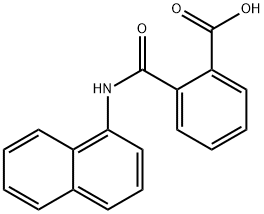Chemical Properties
solid with an unpleasant odour
Uses
N-(1-Naphthyl)phthalamic Acid is an auxin-transport inhibitor in plants resulting in the attenuation of root growth through decreasing the cell production rate.
Uses
Selective preemergence herbicide used to control some grasses and many broadleaved
weeds in soybeans, cucurbits, asparagus, groundnuts, potatoes and established
woody ornamentals.
Definition
ChEBI: A dicarboxylic acid monoamide which results from addition of one equivalent of 1-naphthylamine to phthalic anhydride.
General Description
Naptalam is a purple crystalline solid, which can be used as an anti-geotropic agent and as an auxin (IAA) antagonist in plants.
Agricultural Uses
Herbicide: Used as a selective pre-emergence herbicide to control
broadleaf weeds and grasses in soybeans, cucumbers,
melons, peanuts and woody ornamentals. Not currently
registered for use in the U.S. or EU countries. There are
25 global suppliers.
Trade name
N-1-naphthyl-
Trade Names: ALANAP®[C]; ALANAPE®;
ANCRACK®; DYANAP®; GRELUTIN®; MORCRAN
®; NAPTRO®; NIP-A-THIN®; PEACH-THIN®;
RESCUE®[C]; 6Q8®; SOLO®
Environmental Fate
Soil/
Plant. Degrades in soils and plants forming 1-naphthylamine and phthalic acid
(Hartley and Kidd, 1987; Humburg et al., 1989). Residual activity in soil is limited to
approximately 3 to 4 months (Hartley and Kidd, 1987).
Chemical/Physical. Forms N-(1-naphthyl)phthalimide at elevated temperatures (Worthing
and Hance, 1991). Naptalam will precipitate as the free acid in very acidic waters
or in extremely hard waters (Humburg et al., 1989).
Purification Methods
Crystallise the herbicide from EtOH (m 183-185o). The Na salt has m 185o. [Beilstein 12 H 1236, 12 I 525, 12 III 2876.]

